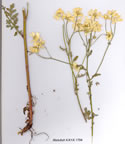| Asteraceae |
 Tanacetum balsamita subsp. balsamita |
 Tanacetum balsamita subsp. balsamita |
| Tanacetum L. (EMEND. BRIQ.) Tanacetum balsamita L. subsp. balsamita L. Ömür: Çok yıllık Yapı: ot Hayat formu: İlk çiçeklenme zamanı: 7 Son çiçeklenme zamanı: 9 Habitat: nemli alan, ekil, alan Minimum yükseklik: 1100 Maksimum yükseklik: 2050 Endemik: - Element: ? Türkiye dağılımı: O. Anadolu, D. Anadolu Genel dağılımı: Avrupa, Kafkasya, K. İran, O. Asya Bulunduğu kareler :A7 A8 A9 B4 B5 B7 B8 B9 C5 C9 C10 |
| T. balsamita L., Sp. Pl. 845 (1753). Rhizomatous perennial. Stems 35-80 cm, sparsely pubescent, branched above. Basal leaves simple, ovate-elliptic, 12-20 cm (incl. 8-15 cm petioles) x 1.5-5 cm, acute or subobtuse at apex, cordate, truncate or cuneate at base, margin crenate-serrate, adpressed-pubescent on both surfaces; cauline similar, decreasing in size, shortly petiolate below, becoming sessile above, sometimes pinnatisect with 1-2 pairs of oblong segments at base. Capitula usually numerous, (3-)30-100 in loose terminal corymbs. Involucre 5-8 mm broad; phyllaries 3-seriate, lanceolate or obiong, pale- or dark-margined, outer 2.5 x 0.75 mm, inner 3-3.5 x 1 mm. Ray flowers 12-15 or absent, ligules white, 3.5-7 x 1.75-3.5 mm. Disc flowersyellow, 2 mm. Achenes ± terete, 5(-7)-ribbed, 2 mm; corona entire or minutely toothed, 0.2-0.4 mm. Fl. 7-9. Moist ground, sometimes cultivated, 1100-3000 m. 1. Capitula discoid subsp. balsamita 1. Capitula radiate subsp. balsamitoides subsp. balsamita. Syn: Balsamita major Desf. in Actes Soc. Hist. Nat. Paris 1:3 (1792); B. vulgaris Willd., Sp. Pl. 3:1802 (1803); B. suaveolens Pers., Synops. Pl. 2:408 (1807); Pyrethrum tanacetum DC, Prodr. 6:63 (1838); P. balsamita (L.) Willd. var. tanacetoides Boiss., Fl. Or. 3:346 (1875); P. majus (Desf.) Tzvel. in Fl. URSS 26:198 (1961). Ic: Hegi, I11. Fl. Mittel-Eur. 6(2):599 (1928). Map 24, p. 275. Described from Europe (cult. specimen) (Hb. Linn. 987/10!). Scattered in C. & E. Anatolia. A8 Gümüşane: Kop Da., 1525 m, Balls 1978! B4 Ankara: Beynam, D. 13040a! B5 Kayseri: 5 km S. of Ürgüp, 1100 m, Roper 160! B7 Tunceli: Ovacik to Hozat, 2050 m, D. 31574! C5 Konya: Ereğli, Allah-verdi (Azn.)! Throughout Europe (except the North) to Caucasia, N. Iran and C. Asia, possibly only as an escape from cultivation. subsp. balsamitoides (Schultz Bip.) Grierson in Notes R.B.G. Edinb. 33:434 (1975). Syn: Chrysanthemum balsamita L., Sp. Pl. ed. 2, 1252 (1763) non Tana-cetum balsamita L.; Matricaria balsamita (L.) Desr. in Lam., Encycl. 3:733 (1792); Pyrethrum balsamita (L.) Willd., Sp. Pl. 3:2153 (1803); Tanacetum balsamitoides Schultz Bip., Tanacet. 51 (1844); Chrysanthemum balsamitoides Náb. in Publ. Fac. Sci. Univ. Masaryk Brno 52:22 (1925); Pyrethrum balsami-toides (Náb.) Tzvel. in Fl. URSS 26:196 (1961). Ic: Nábělek in Publ. Fac. Sci. Univ. Masaryk Brno 52: t. 5 f. 2 (1925) as Chrysanthemum balsamitoides. Map 24, p. 275. Based on Chrysanthemum balsamita L. from the Orient (Hb. Linn. 1012/10!). N.E. & E. Anatolia. A7 Gümüşane: d. Bayburt, Kop Da., 1525 m, Balls 1982! A8 Rize: Ikizdere above Cimil, 2700 m, D. 21119! Erzurum: Erzurum to Tortum, 2200 m, Holtz et al. 881! A9 Çoruh: Yalnizçam Da. between Ardahan and Artvin, 2350 m, D. 32531! Kars: Sarikamiş to Karakurt, 2150 m, D. 46559! Ağri/Erzurum: Tahir pass, 2440 m, Archibald 3231! B7 Tunceli: Munzur Da. above Ovacik, 2300 m, D. 31404! Erzincan: Sipikör Da., Sint. 1890:3256! B8 Muş: Çaylar, 1600 m, D. 46362! Erzurum: Palandöken Da., 2350 m, D. 47390! B9 Ağri: Suluçem Da. (Musun), 2250 m, D. 47077! Bitlis: Bitlis to Shemaran, B.Post 674! Van: Çatak, Kavuşşahap Da., 2745 m, D. 23033! C9 Hakkari: Cilo Da., 2745 m, D. 23973! C10 Hakkari: Yüksekova, 1950 m, Duncan & Tait 192! Soviet Armenia, N.W. Iran. Vegetatively there is no difference between the subspecies, but the typical one generally bears more numerous and smaller capitula than subsp. balsamitoides, the corymbs of which seldom exceed 30 capitula. The phyllaries may have green or pale brown margins in both subspecies but they are never dark-margined in subsp. balsamita. The presence or absence of the ray flowers is the only absolute point of difference between the two. Subsp. balsamita has been cultivated in Europe (as Costmary) since mediaeval times as a culinary and medicinal herb. Possibly it only occurs in gardens or as an escape from cultivation, or it may be native only to the Munzur Da. and Kop Da. regions in E. Anatolia where both subspecies grow. Having examined the Turkish material of this species, I cannot confirm the observations by Boissier (Fl. Or. 3:346, 1875) and Briquet (in Burnat, Fl. Alp. Mark. 6:128, 1916), both of whom declare that forms with reduced ligules may be found; in Anatolia they are either absent, or present and conspicuous. Although Hading (Acta Hort. Berg. 16:1-56, 1951) from an embryological standpoint (stressing the extraordinary development of its 4-sporic embryo sac) and Favarger (Rev. Cytol. et Biol. Vègèt. 29:191-197, 1966) from phytochemical evidence both recommend that this species should be removed from Tanacetum and placed in a separate genus, Balsamita, paucity of morphological differences prevent this recommendation from being put into practice here. |